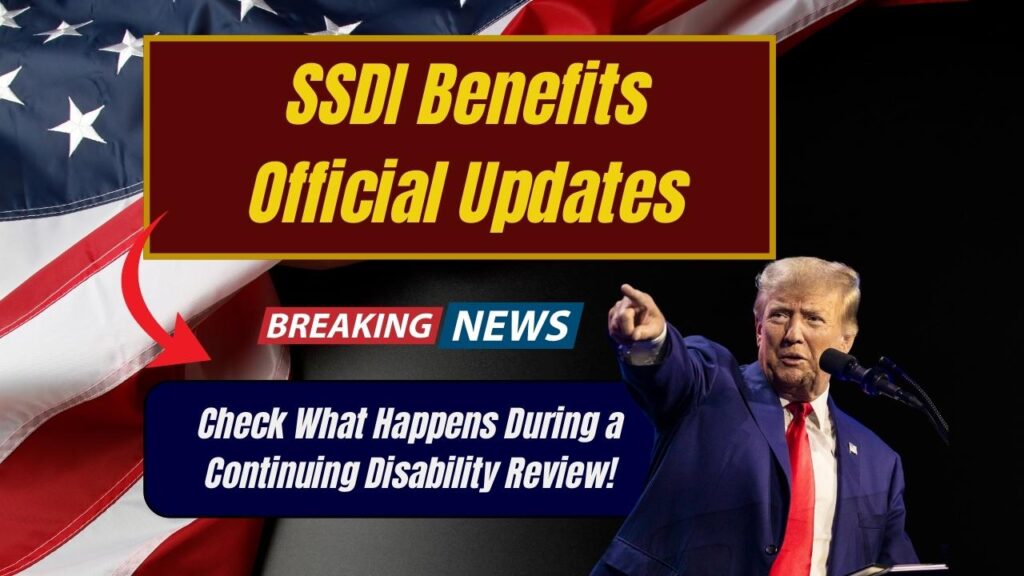SSDI Benefits Official Updates: Check What Happens During a Continuing Disability Review!
SSDI Benefits Official Updates – If you’re receiving SSDI benefits (Social Security Disability Insurance), there’s something you definitely want to keep on your radar—Continuing Disability Reviews (CDRs). It could mean the difference between keeping your monthly benefits or suddenly losing them. Uncle Sam doesn’t just hand out money and walk away—they check back in from time to time to make sure you still qualify.

So, what exactly happens during a CDR? How do you stay prepared? Let’s break it all down with no fluff—just straight talk, real facts, and what you can do to protect your SSDI payments.
SSDI Benefits Official Updates
| Point | Details |
|---|---|
| What is a CDR? | A periodic review by the SSA to see if you still qualify for SSDI benefits. |
| Review Frequency | Based on medical status: Every 6 months–7 years. |
| Main Forms | SSA-455 (short) and SSA-454 (long form). |
| Work Impact | Earning over the Substantial Gainful Activity (SGA) limit may stop benefits. |
| SGA Amount in 2025 | $1,620/month ($2,700/month for blind individuals). |
| Protections | Ticket to Work program, 24-month rule, appeal rights. |
| Official Website | ssa.gov |
SSDI Continuing Disability Reviews aren’t meant to scare you—they’re part of keeping the system fair. But the truth is, if you’re not prepared, you could lose your benefits. Stay proactive: document your condition, follow treatment, know your rights, and use the programs available to protect yourself.
What Is a Continuing Disability Review (CDR)?
The Social Security Administration (SSA) uses a CDR to check in on your medical condition. Think of it like a status update—but for your health. If they think you’ve medically improved and can now return to work, your SSDI benefits could stop. But don’t panic yet—this isn’t an automatic “you’re off the list.”
The SSA reviews whether your condition has improved, if you can now work full-time, and whether your work activity crosses the income threshold (SGA).
This review is all about making sure the rules are still being met. Not a trap, just protocol. But you do need to take it seriously.
When and How Often Will SSA Review You?
Here’s the scoop: how often you get reviewed depends on your condition.
Categories of Review Frequency
- Medical Improvement Expected (MIE): Reviewed in 6–18 months.
- Medical Improvement Possible (MIP): Reviewed every 3 years.
- Medical Improvement Not Expected (MINE): Reviewed every 5–7 years.
If your doctor’s notes and test results show that your condition isn’t likely to improve, you’ll be placed in the MINE category. But if there’s a chance you might get better? Expect a quicker check-in.
Your initial award letter usually tells you what category you’re in.
The CDR Process: Step-by-Step for SSDI Benefits Official Updates?
Let’s walk through what really happens when your CDR is triggered:
1. Notification from SSA
You’ll get a letter in the mail letting you know that your SSDI case is being reviewed. This is your heads-up that it’s time to gather records.
2. Fill Out the Right Form
- SSA-455 (Disability Update Report) – A simple, two-page form asking if your condition has changed.
- SSA-454 (Full CDR Report) – A detailed 10-page form if your case needs a deeper dive.
You can fill these out by mail or online via your My Social Security Account.
3. Medical Evidence Review
The SSA looks at your recent doctor visits, prescription meds, therapy notes, hospitalizations, and mental health status. They may even call your doctors directly.
4. Consultative Exam (if needed)
If they don’t have enough info, SSA may set you up with a free medical exam—known as a Consultative Exam (CE). You must attend this or risk losing benefits.
5. SSA Decision
Once they’ve got everything, they’ll make a call: benefits continue if no improvement; benefits stop if they believe you can return to work. You’ll be notified of the outcome by mail.
What Happens If SSA Says You’re No Longer Disabled?
You’ll get a Cessation Notice and a chance to appeal. Here’s what to do:
- File a Request for Reconsideration (Form SSA-789) within 60 days.
- You can ask to keep benefits going while your appeal is reviewed.
- If denied again, you can request a hearing before a judge.
Pro Tip: Get a disability lawyer at this point. Appeals are tough to win alone.
Work and SSDI: What If You’re Working?
SSA allows you to test the waters through a Trial Work Period (TWP)—a 9-month window where you can earn above the limit without losing your benefits.
But after that:
- If you make more than $1,620/month in 2025, SSA may assume you’re back in the workforce for good.
- For blind individuals, the limit is higher: $2,700/month.
So yes, working is allowed, but stay below the radar—or stay transparent with SSA.
Protections You Should Know About
Ticket to Work Program
If you’re enrolled in this program and following your plan, SSA can’t terminate your benefits just because you’re working.
Learn more about Ticket to Work
The 24-Month Rule
If you’ve been receiving SSDI for at least 24 months, work alone won’t trigger a medical CDR. That’s some peace of mind if you’re easing back into employment.
Expedited Reinstatement (EXR)
If your benefits stopped because you returned to work but your disability returns within 5 years, you can apply for Expedited Reinstatement without a new application. During the review, SSA may even provide provisional benefits.
How to Prepare for a CDR
- Keep copies of all medical records, appointment summaries, lab results, and diagnoses.
- Make sure your doctors know your functional limitations and document them clearly.
- Don’t skip appointments or stop treatment unless medically advised.
- Keep SSA updated on address changes to avoid missing review notices.
- Track all work activity, pay stubs, and hours if employed.
SSI, SSDI, and VA Benefits in May 2025 — When Your Social Security Check Will Arrive
Massive $5,200 Boost for SSI, SSDI, and Social Security Recipients in 2025 — Are You Eligible?
VA Disability Benefits Boost in 2025 – 90% Rating Means Bigger Payouts!
FAQs About SSDI Benefits Official Updates
Q1: Will my SSDI benefits stop immediately if I’m reviewed?
No. The process takes weeks to months. You’ll get notified and have time to appeal if needed.
Q2: What if I ignore the review notice?
Failing to respond could lead to termination of benefits.
Q3: Do children receiving SSDI get reviewed too?
Yes. Children undergo CDRs, usually every 3 years. At age 18, they must meet adult disability standards.
Q4: Can I get legal help for my CDR?
Yes. Disability attorneys specialize in SSA reviews and appeals—and many don’t charge unless you win.
Q5: Does working part-time trigger a CDR?
Not always. But if you’re earning above the SGA limit, it could raise red flags. Document everything.
Q6: What’s the best way to prove I’m still disabled?
Consistent and well-documented medical treatment is your best defense. Be honest and thorough in reporting symptoms and limitations.







